To survive on the foredunes, plants need to be adapted to harsh conditions – salt-laden winds, low nutrient levels, strong sunlight and burial by wind-blown sand. They have an important role in binding the sand and quickly colonising bare areas after erosion events.
Grasses and sedges |
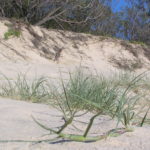 Beach spinifex, Spinifex sericeus Beach spinifex, Spinifex sericeusThe long stems of Spinifex grow right to the front of the incipient foredune, sending down roots at the nodes. It also spreads via the spherical “tumbleweed” clumps of seedpods that roll along the beach propelled by wind. It has tough leaves covered in silky hairs.More information here. |
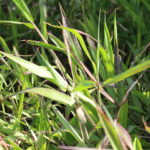 Wheat grass, Ischaemum triticeum Wheat grass, Ischaemum triticeumThis is a coarse grass with stems up to a couple of metres long. The leaves often have a reddish tinge.More information here and here. |
Creepers and climbers |
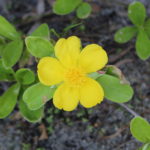 Twining guinea flower, Hibbertia scandens Twining guinea flower, Hibbertia scandensThis is a vine that scrambles over the sand and sometimes climbs into trees. It has glossy leaves and 5-petalled bright yellow flowers that produce a capsule of red seeds. Not to be confused with the introduced weed Beach primrose, which has hairy green-grey leaves and 4-petalled pale yellow flowers.More information here and here. |
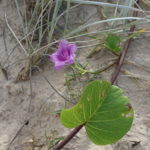 Goat’s foot, Ipomoea pes-caprae subsp. brasiliensis Goat’s foot, Ipomoea pes-caprae subsp. brasiliensisThis vine gets its name from the shape of its leaves (pes-caprae is Latin for goat’s foot), which are folded upwards at the midrib. The flowers are pink to mauve. It grows down to the incipient foredune along with spinifex.More information here. |
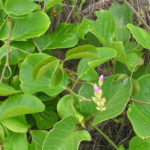 Beach bean, Canavalia rosea Beach bean, Canavalia roseaAnother vine that grows down to the incipient foredune, Beach bean has three-lobed leaves and purple-pink pea-type flowers that produce poisonous seed pods.More information here and here. |
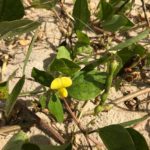 Dune bean, Vigna marina Dune bean, Vigna marinaThe three-lobed leaves of Dune bean are similar to those of Beach bean, but the flowers are yellow. These are followed by bean-like pods which release their seeds when they dry out. This plant is found on beaches all over the world.More information here and here. |
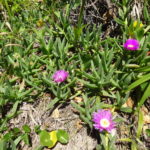 Coastal pigface, Carpobrotus glaucescens Coastal pigface, Carpobrotus glaucescensEasily recognised by its succulent, three-cornered leaves, Pigface trails across the sand, sending down roots which stabilise the dunes. The bright pink flowers are followed by edible red fruit.More information here and here. |
 Stephania, Stephania japonica Stephania, Stephania japonicaThis wiry creeper has glossy heart-shaped leaves. It is sometimes known as Snake vine. There are separate male and female plants and the female has pale yellow flowers followed by red berries.More information here. |
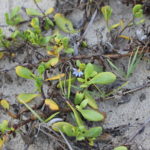 Fan flower, Scaevola calendulacea Fan flower, Scaevola calendulaceaThis is a prostrate plant with fleshy leaves and fan-shaped blue flowers. The fruit is a bluish-purple berry.More information here. |
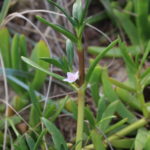 Sea purslane, Sesuvium portulacastrum Sea purslane, Sesuvium portulacastrumThis is a succulent creeper with glossy strap-like leaves and stems that vary in colour from green to purplish red. It bears pink five-petalled flowers for most of the year. Sea purslane is not endemic to Australia, being found though much of the world.More information here. |
Herbs |
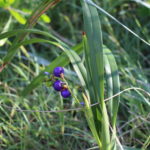 Beach flax lily, Dianella congesta Beach flax lily, Dianella congestaThis tufted plant often grows in colonies because it spreads by underground roots. It has strap-like leaves with blue flowers followed by bright blue berries.More information here. |
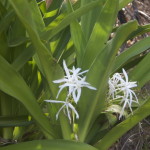 Crinum lily, Crinum pedunculatum Crinum lily, Crinum pedunculatumThe strap-like leaves of this plant can be over a metre long and 10 cm wide. The white spidery flowers are borne in clusters and are followed by golfball-sized seed capsules.More information here, here and here. |
Shrubs |
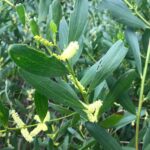 Coastal wattle, Acacia sophorae Coastal wattle, Acacia sophoraeThe natural range of this wattle is south of the Maroochy River, but it’s been planted widely elsewhere to stabilize dunes. In many parts of Australia it has become a weed. It bears typical yellow flower spikes, followed by long seed pods.More information here and here. |
Trees |
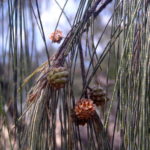 Beach she-oak, Casuarina equisetifolia var. incana Beach she-oak, Casuarina equisetifolia var. incanaViewed from the beach, this is the most obvious tree on the frontal dunes. It’s easily identifiable by its weeping foliage and characteristic seed cones. It plays an important role in fixing nitrogen from the atmosphere and adding it to the soil.More information here, here and here. |
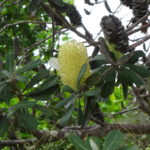 Coastal banksia, Banksia integrifolia subsp. integrifolia Coastal banksia, Banksia integrifolia subsp. integrifoliaThe leaves of this Banksia are dull green above and white below. The flowers are pale yellow and are followed by a woody cone whose follicles open when mature to release winged seeds.More information here. |
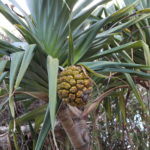 Pandanus, Pandanus tectorius Pandanus, Pandanus tectoriusThe leaves of this tree are spirally arranged and have small teeth along the edges. Larger trees are usually supported by prop roots. The female plants produce a pineapple-like seed cone whose individual seeds separate and drop when ripe. They can be roasted and eaten.More information here, here and here. |
